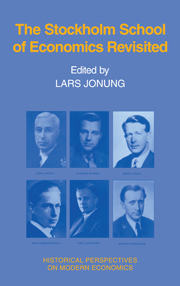Book contents
- Frontmatter
- Dedication
- Contents
- Preface
- List of Contributors
- Dramatis Personae at the end of 1937
- Introduction and Summary
- Part I The roots
- Part II The approach of the Stockholm School
- 4 Expectation and plan: The microeconomics of the Stockholm School
- 5 Sequence analysis and optimization
- 6 There were two Stockholm Schools
- 7 On formal dynamics: From Lundberg to chaos analysis
- 8 Lundberg, Keynes, and the riddles of a general theory
- 9 Macrodynamics and the Stockholm School
- 10 Ohlin and the General Theory
- 11 The monetary economics of the Stockholm School
- 12 The Austrians and the Stockholm School: Two failures in the development of modern macroeconomics?
- 13 The political arithmetics of the Stockholm School
- 14 After the Stockholm School
- Part III The impact of the Stockholm School
- Part IV What remains of the Stockholm School?
- The Stockholm School: A non-Swedish bibliography
5 - Sequence analysis and optimization
Published online by Cambridge University Press: 05 July 2013
- Frontmatter
- Dedication
- Contents
- Preface
- List of Contributors
- Dramatis Personae at the end of 1937
- Introduction and Summary
- Part I The roots
- Part II The approach of the Stockholm School
- 4 Expectation and plan: The microeconomics of the Stockholm School
- 5 Sequence analysis and optimization
- 6 There were two Stockholm Schools
- 7 On formal dynamics: From Lundberg to chaos analysis
- 8 Lundberg, Keynes, and the riddles of a general theory
- 9 Macrodynamics and the Stockholm School
- 10 Ohlin and the General Theory
- 11 The monetary economics of the Stockholm School
- 12 The Austrians and the Stockholm School: Two failures in the development of modern macroeconomics?
- 13 The political arithmetics of the Stockholm School
- 14 After the Stockholm School
- Part III The impact of the Stockholm School
- Part IV What remains of the Stockholm School?
- The Stockholm School: A non-Swedish bibliography
Summary
Is it possible to give macrosequence analysis in the Stockholm School tradition a micro-foundation, assuming that households and firms are optimizing economic agents? If not, what can be done?
The Wicksellian cumulative process, Schumpeter's innovation–driven growth, and Knight's theory of uncertainty and profit were three starting points for the Stockholm School. In order to give Wicksell's concept of a “natural rate of interest” a strict formulation under the dynamic assumptions, the Stockholm School tried to model how profit maximization determines the volume of investment under the assumption that, because of innovations, ex ante yield includes an uncertain component of pure profit. Furthermore, it was an aim of the Stockholm School to model not only the steady-state volume of investment in a stable growth process but also, and in particular, the adjustment path after macroeconomic disturbance, for instance, an increase in the market rate of interest above the natural rate. The time sequence after such a disturbance was the focus of analysis.
The purpose of this paper is to raise the question whether this program led the Stockholm School into a cul-de-sac or whether the necessary analytical tools just were not available in the 1930s. I inherited the problem from my teachers Erik Lundberg and Ingvar Svennilson, and I struggled with it in my dissertation, Monetary and Fiscal Policy under Uncertainty (Faxén, 1957). The solution that I arrived at was to combine the ideas of the Stockholm School with those of von Neumann and Morgenstern's Theory of Games and Economic Behavior (1944).
- Type
- Chapter
- Information
- The Stockholm School of Economics Revisited , pp. 167 - 176Publisher: Cambridge University PressPrint publication year: 1991
- 3
- Cited by

